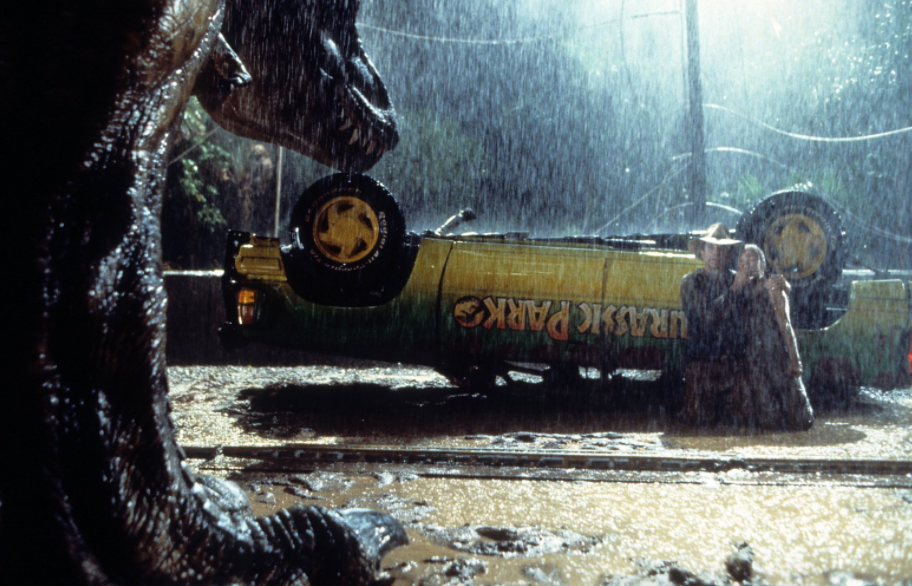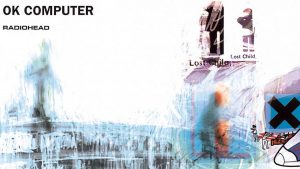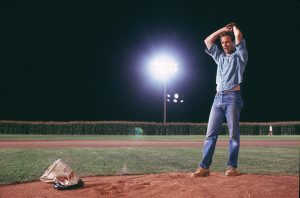Anyone who complains that CGI is ruining movies needs to see Jurassic Park. The blend of CGI and animatronics could be a how-to guide for any filmmaker on using CGI well. Even though it is primarily known for its awe-inspiring visuals, Jurassic Park does more than just wow with its lifelike depiction of extinct dinosaurs. It tells a gripping story that seamlessly blends the themes of morality, science, and ambition while crafting incredibly intense action scenes, all involving dinosaurs. Director Steven Spielberg oscillates between awe at the magnificence of his cinematic creations, and fear for their destructive might.
The film starts on a small scale with a scene that could be straight out of a horror film. With almost no dialogue, Spielberg establishes the setting: a mysterious island called Isla Nublar and a group of workers trying to transport some kind of animal (a velociraptor, although it is only referred to as “her” in this scene). Naturally, something goes wrong and one of the men is killed by the animal. Spielberg’s direction is sublime: he leaves most of the scene up to the viewer’s imagination. We only get brief flashes of the velociraptor’s eyes. The camera focuses on the worker caught in the raptor’s grasp, and the futile attempts of his peers to save him. It is a perfect introduction to the raptor as a villain, and it demonstrates the sheer ferocity of the dinosaurs in the film. The dark lighting and close-up shots only serve to heighten the terror. An entire article could be devoted to how brilliantly constructed this opening scene is.
After the nail-biting opening, the film ratchets down the tension to allow the audience time to breathe. Not enough is said about how deliberately paced the next forty-five minutes of the film are: Spielberg introduces the characters and presents their backgrounds in a clear, succinct manner, and makes it extremely easy for the audience to understand the stakes of the story. Once on the island, Spielberg builds to the first shot of the brontosauruses in an incredibly iconic scene. He does not try to fool the audience, but instead presents the visuals with complete confidence. And it works. Even today, the 1993 CGI holds up, and it is difficult to watch the scene without a sense of awe at the elegant beasts at hand.
Even after this sweeping scene, Spielberg continues to build the film’s world. We gets the scientific explanation for the creation of the dinosaurs, hints at what a functional park would look like, and the birth and feeding of the velociraptors. What is vital here is that we are brought into the world of Jurassic Park with the rest of the characters. Our experiences are the same as theirs. This pays off in a big way when Spielberg gets to the big reveal: the Tyrannosaurus Rex. It is, simply put, one of the best set-pieces in cinematic history.
Once again, the build-up to the T-Rex attack is slow and methodical. Like the characters in the cars, we are disappointed by the fact that we get no look at the dinosaurs behind the electrified fences. And yet, we cannot relax completely. We know that something is wrong, that Dennis Nedry is plotting something, and that there is a storm coming, literally in the movie and figurative for the characters. The tension is only heightened because instead of having a total meltdown all at once, Spielberg prefers to let the chaos set in with a slow drip. First the cars stop. Then the control room starts to realize that something is wrong. Then the rain sets in. Once the terror starts, it is unflinching.
Much has been written about why the visual effects in the movie hold up after 20 some-odd years. The darkness and rain serve to both amplify the CGI and make the T-Rex even more horrifying. What is key here is the pacing of the scene. Like with the rest of the film, Spielberg rushes nothing. Every development is explained and shown, and the scene benefits from how layered the action is. We get everything from a lawyer getting eaten off a toilet to a move-and-he’ll-see-us moment to Lex and Grant hanging on a wire as a car threatens to crush them. It is a wonderfully varied action scene that manages to put the characters in countless different life-threatening situations without ever becoming laden down by the number of crises. It is so well put-together that you won’t even notice the fact that the drop into the ravine makes no sense geographically. (But who cares?)
The T-Rex would return sparingly throughout the film, only really making another great moment during the climax (the car chase is fun, if forgettable). The stars for the rest of the film are undoubtedly the velociraptors. The “Clever Girl” scene is pitch perfect and one of the more brutal deaths in film. The entire sequence when Ellie tries to turn the power back on is also great, even if the fake-arm-on-shoulder bit is a little silly. The real treat is the entirety of the kitchen scene. Here, the raptors go full-on horror movie villain. The set-up is, once again, extremely simple: Lex and Tim are attempting to evade the raptors and end up trapped in the kitchen. What makes this scene work is the fact that Spielberg trusts his effects so much. There is no dark lighting to obscure the raptors from sight, and he does not succumb to the temptation of using their stealth for a jump scare. Instead, it’s pure, unadulterated suspense as two children attempt to escape from these vicious animals. It is a perfect set-piece that, although quite different from the Tyrannosaurus scene, still rivals it for tension.
Entire books could be written about what a near-perfect film Jurassic Park is. Yes, there are certainly plot-holes along the way, but it is such a well-made film that you won’t stop to notice them. Credit must also be given to screenwriter David Koepp for developing Michael Crichton’s original science-heavy story with a screenplay that contains plenty of philosophical musing, humor, and memorable lines. (Nothing can beat Jeff Goldblum’s “Life, uh, finds a way.”) With the huge success of Jurassic World, it appears that the franchise is back in the pop-culture lexicon. It’s still important for the filmmakers to remember that what made the first film so great wasn’t a desire for huge spectacle, but rather an attempt to keep the characters front and center and the stakes Compsognathus-sized.





